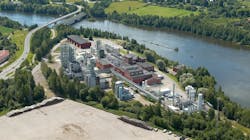Solvay signs PPA to power Finnish H2O2 plant with Wind Power
Solvay signed a 10-year Utility Power Purchasing Agreement (PPA) with Statkraft for its Voikkaa site in Finland, which produces hydrogen peroxide.
The PPA will ensure that the plant will run on 100% wind-generated electricity and thus, contribute to the achievement of Solvay’s sustainability targets.
Under the PPA, Statkraft will deliver electricity from the Pajuperankangas wind farm. It has recently signed a 10-year PPA with project developer ABO Wind. The wind farm is scheduled to be connected to the grid in fall 2021. It will consist of 14 turbines and a combined installed capacity of 86.8 MW, enough to power 14,000 electricity-heated homes in Finland.
“In line with the Group’s sustainability roadmap, Solvay One Planet, Solvay Peroxides has the ambition to reach carbon neutrality globally by 2040,” said Solvay Peroxides EMEA Business Director Marco Giannuzzi. “Through this PPA, we are pleased to be taking a significant step forward in reducing the environmental impact of our Finnish site, responding to the needs of the planet and our customers.”
Solvay started the Voikka H2O2 plant 50 years ago in cooperation with Finnish paper and pulp manufacturers. The facility produces about 85 kilotons of hydrogen peroxide annually, according to the company.
About the Author
EnergyTech Staff
Rod Walton is senior editor for EnergyTech.com. He has spent 17 years covering the energy industry as a newspaper and trade journalist.
Walton formerly was energy writer and business editor at the Tulsa World. Later, he spent six years covering the electricity power sector for Pennwell and Clarion Events. He joined Endeavor and EnergyTech in November 2021.
He can be reached at [email protected].
EnergyTech is focused on the mission critical and large-scale energy users and their sustainability and resiliency goals. These include the commercial and industrial sectors, as well as the military, universities, data centers and microgrids.
Many large-scale energy users such as Fortune 500 companies, and mission-critical users such as military bases, universities, healthcare facilities, public safety and data centers, shifting their energy priorities to reach net-zero carbon goals within the coming decades. These include plans for renewable energy power purchase agreements, but also on-site resiliency projects such as microgrids, combined heat and power, rooftop solar, energy storage, digitalization and building efficiency upgrades.
